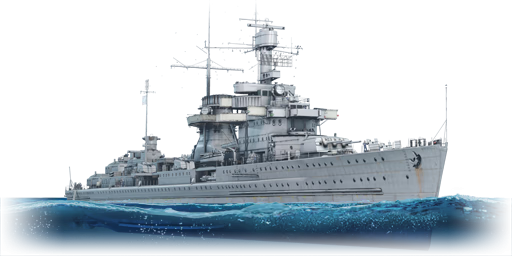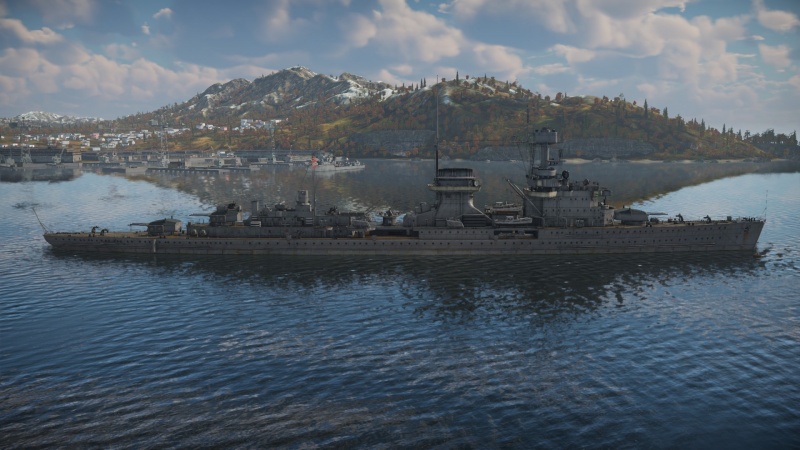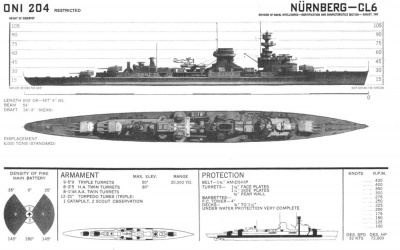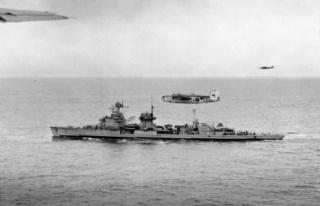Difference between revisions of "Nürnberg"
(→Ammunition: Converted to transclusion) |
m (→Description) |
||
| (2 intermediate revisions by 2 users not shown) | |||
| Line 6: | Line 6: | ||
== Description == | == Description == | ||
<!-- ''In the first part of the description, cover the history of the ship's creation and military application. In the second part, tell the reader about using this ship in the game. Add a screenshot: if a beginner player has a hard time remembering vehicles by name, a picture will help them identify the ship in question.'' --> | <!-- ''In the first part of the description, cover the history of the ship's creation and military application. In the second part, tell the reader about using this ship in the game. Add a screenshot: if a beginner player has a hard time remembering vehicles by name, a picture will help them identify the ship in question.'' --> | ||
| − | The '''{{Specs|name}}''' | + | The '''{{Specs|name}}''' was the second ship of the Leipzig-class light cruisers, built for the Kriegsmarine in the mid-1930s. She was laid down in 1934 and commissioned on 2nd November 1935. The Nürnberg when built was armed with nine 15 cm SK C/25 cannons in three triple turrets with two located aft and one on bow of the ship. Secondary armament consisted eight 8.8 cm/76 SK C/32 guns for anti-aircraft protection together with eight 3.7 cm SK C/30 cannons and eight 2cm SK/38 autocannons. The ship was also armed with four triple torpedo tubes carrying 24 torpedoes in total. These torpedo tubes were removed in a 1942 refit of the ship, being reduced to two triple tubes. The ship served in Spanish Civil War intervention patrols without major incident. After the outbreak of WWII, she laid minefields in the North Sea, where she was also torpedoed by British submarine HMS Salmon on 13th December 1939 together with her sister ship [[Leipzig]]. After repairs in drydock and a refit, Nürnberg was sent to Norway for a brief period until she became a training ship all the way until 1945. Her last sortie of the war was conducted on 13th January when she sortied to lay minefields from Oslo. On 24th January, she arrived in Copenhagen where she spent the rest of the war. On 22nd May 1945, British cruisers HMS Dido and HMS Devonshire arrived to take her over. After the war, she became the only Kriegsmarine ship to see active duty after the end of WWII. She was handed over to the Soviet Navy by the British as war reparations where she served as a training ship under the name Admiral Makarov in Kronshtadt until 1960 when she was broken up for scrap. |
| + | |||
| + | The Nürnberg was introduced in [[Update 1.87 "Locked On"]]. She is the last German cruiser captains come across. The playstyle of Nürnberg is very similar to her sister Leipzig or K-class cruiser [[Köln]]. The main difference between her and Leipzig is the ability to carry torpedoes. Unlike Leipzig, the Nürnberg's main armament turret armour was increased from 30 to 80 mm at front and from 20 to 35 mm on the rear. The Nürnberg possesses impressive firepower as her main guns can fire up to 12 rounds per minute, however, the ship itself and the magazines in particular are very lightly protected by 50 mm belt armour and are located above the waterline, making them extremely vulnerable to fatal explosions. The long-range anti-aircraft suite consists of four pairs of 8.8 cm cannons with HE-TF shells, while close-range protection is made up of various 40 mm, 37 mm, and 20 mm cannons. The Nürnberg is capable of dealing heavy damage to enemy ships, but caution is needed as the ship cannot sustain enemy fire for long. | ||
== General info == | == General info == | ||
Latest revision as of 17:11, 24 September 2023
Contents
Description
The Leipzig-class, Nürnberg, 1944 was the second ship of the Leipzig-class light cruisers, built for the Kriegsmarine in the mid-1930s. She was laid down in 1934 and commissioned on 2nd November 1935. The Nürnberg when built was armed with nine 15 cm SK C/25 cannons in three triple turrets with two located aft and one on bow of the ship. Secondary armament consisted eight 8.8 cm/76 SK C/32 guns for anti-aircraft protection together with eight 3.7 cm SK C/30 cannons and eight 2cm SK/38 autocannons. The ship was also armed with four triple torpedo tubes carrying 24 torpedoes in total. These torpedo tubes were removed in a 1942 refit of the ship, being reduced to two triple tubes. The ship served in Spanish Civil War intervention patrols without major incident. After the outbreak of WWII, she laid minefields in the North Sea, where she was also torpedoed by British submarine HMS Salmon on 13th December 1939 together with her sister ship Leipzig. After repairs in drydock and a refit, Nürnberg was sent to Norway for a brief period until she became a training ship all the way until 1945. Her last sortie of the war was conducted on 13th January when she sortied to lay minefields from Oslo. On 24th January, she arrived in Copenhagen where she spent the rest of the war. On 22nd May 1945, British cruisers HMS Dido and HMS Devonshire arrived to take her over. After the war, she became the only Kriegsmarine ship to see active duty after the end of WWII. She was handed over to the Soviet Navy by the British as war reparations where she served as a training ship under the name Admiral Makarov in Kronshtadt until 1960 when she was broken up for scrap.
The Nürnberg was introduced in Update 1.87 "Locked On". She is the last German cruiser captains come across. The playstyle of Nürnberg is very similar to her sister Leipzig or K-class cruiser Köln. The main difference between her and Leipzig is the ability to carry torpedoes. Unlike Leipzig, the Nürnberg's main armament turret armour was increased from 30 to 80 mm at front and from 20 to 35 mm on the rear. The Nürnberg possesses impressive firepower as her main guns can fire up to 12 rounds per minute, however, the ship itself and the magazines in particular are very lightly protected by 50 mm belt armour and are located above the waterline, making them extremely vulnerable to fatal explosions. The long-range anti-aircraft suite consists of four pairs of 8.8 cm cannons with HE-TF shells, while close-range protection is made up of various 40 mm, 37 mm, and 20 mm cannons. The Nürnberg is capable of dealing heavy damage to enemy ships, but caution is needed as the ship cannot sustain enemy fire for long.
General info
Survivability and armour
Talk about the vehicle's armour. Note the most well-defended and most vulnerable zones, e.g. the ammo magazine. Evaluate the composition of components and assemblies responsible for movement and manoeuvrability. Evaluate the survivability of the primary and secondary armaments separately. Don't forget to mention the size of the crew, which plays an important role in fleet mechanics. Save tips on preserving survivability for the "Usage in battles" section. If necessary, use a graphical template to show the most well-protected or most vulnerable points in the armour.
Mobility
Write about the ship's mobility. Evaluate its power and manoeuvrability, rudder rerouting speed, stopping speed at full tilt, with its maximum forward and reverse speed.
| Mobility Characteristics | |||
|---|---|---|---|
| Game Mode | Upgrade Status | Maximum Speed (km/h) | |
| Forward | Reverse | ||
| AB | |||
| Upgraded | 70 | 25 | |
| RB/SB | |||
| Upgraded | 60 | 22 | |
Modifications and economy
Armament
Primary armament
Provide information about the characteristics of the primary armament. Evaluate their efficacy in battle based on their reload speed, ballistics and the capacity of their shells. Add a link to the main article about the weapon: {{main|Weapon name (calibre)}}. Broadly describe the ammunition available for the primary armament, and provide recommendations on how to use it and which ammunition to choose.
| Penetration statistics | |||||||
|---|---|---|---|---|---|---|---|
| Ammunition | Type of warhead |
Penetration @ 0° Angle of Attack (mm) | |||||
| 1,000 m | 2,500 m | 5,000 m | 7,500 m | 10,000 m | 15,000 m | ||
| Spgr. L/4.5 Kz (m.Hb) | HE | 37 | 37 | 37 | 37 | 37 | 37 |
| Spgr. L/4.4 Bdz (m.Hb) | SAPBC | 115 | 97 | 74 | 57 | 45 | 35 |
| Spgr. L/4.5 Zt.Z | HE-TF | 37 | 37 | 37 | 37 | 37 | 37 |
| Pzgr. L/3.7 (m.Hb) | APCBC | 289 | 245 | 187 | 144 | 112 | 77 |
| Shell details | ||||||||||||
|---|---|---|---|---|---|---|---|---|---|---|---|---|
| Ammunition | Type of warhead |
Velocity (m/s) |
Projectile mass (kg) |
Fuse delay (s) |
Fuse sensitivity (mm) |
Explosive mass (TNT equivalent) (kg) |
Ricochet | |||||
| 0% | 50% | 100% | ||||||||||
| Spgr. L/4.5 Kz (m.Hb) | HE | 960 | 45.5 | 0 | 0.1 | 3.64 | 79° | 80° | 81° | |||
| Spgr. L/4.4 Bdz (m.Hb) | SAPBC | 835 | 45.5 | 0.015 | 7 | 3.03 | 48° | 63° | 71° | |||
| Spgr. L/4.5 Zt.Z | HE-TF | 835 | 44.8 | 0 | 0.1 | 3.64 | 79° | 80° | 81° | |||
| Pzgr. L/3.7 (m.Hb) | APCBC | 960 | 45.5 | 0.015 | 7 | 1.1 | 48° | 63° | 71° | |||
Secondary armament
Some ships are fitted with weapons of various calibres. Secondary armaments are defined as weapons chosen with the control Select secondary weapon. Evaluate the secondary armaments and give advice on how to use them. Describe the ammunition available for the secondary armament. Provide recommendations on how to use them and which ammunition to choose. Remember that any anti-air armament, even heavy calibre weapons, belong in the next section. If there is no secondary armament, remove this section.
| Penetration statistics | |||||||
|---|---|---|---|---|---|---|---|
| Ammunition | Type of warhead |
Penetration @ 0° Angle of Attack (mm) | |||||
| 100 m | 1,000 m | 2,000 m | 3,000 m | 4,000 m | 5,000 m | ||
| Sprgr. L/4.5 | HE | 11 | 11 | 11 | 11 | 11 | 11 |
| Sprgr. L/4.5 Zt.Z | HE-TF | 11 | 11 | 11 | 11 | 11 | 11 |
| Shell details | ||||||||||||
|---|---|---|---|---|---|---|---|---|---|---|---|---|
| Ammunition | Type of warhead |
Velocity (m/s) |
Projectile mass (kg) |
Fuse delay (m) |
Fuse sensitivity (mm) |
Explosive mass (TNT equivalent) (g) |
Ricochet | |||||
| 0% | 50% | 100% | ||||||||||
| Sprgr. L/4.5 | HE | 950 | 9 | 0 | 0.1 | 698 | 79° | 80° | 81° | |||
| Sprgr. L/4.5 Zt.Z | HE-TF | 950 | 9 | 0 | 0.1 | 698 | 79° | 80° | 81° | |||
Anti-aircraft armament
An important part of the ship's armament responsible for air defence. Anti-aircraft armament is defined by the weapon chosen with the control Select anti-aircraft weapons. Talk about the ship's anti-air cannons and machine guns, the number of guns and their positions, their effective range, and about their overall effectiveness – including against surface targets. If there are no anti-aircraft armaments, remove this section.
Additional armament
Describe the available additional armaments of the ship: depth charges, mines, torpedoes. Talk about their positions, available ammunition and launch features such as dead zones of torpedoes. If there is no additional armament, remove this section.
Usage in battles
The Nürnberg is really just an enhanced Leipzig, and you should play it the same way. Your guns now fire much faster, so feel free to rain down shells on distant opponents, as well as clobber any cruisers that get too close. Your torpedo protection is still there and your armour has improved, so you should be able to take a good chunk of damage from smaller battery fire. You also have a larger crew, and you're even faster. The biggest improvement, aside from the main guns, is the AA battery, which is colossal on the Nürnberg. Enemy aircraft will get mowed down if they get too close, so don't be scared to stick to bigger ships and protect them while they take out the enemy ships you're more scared of.
The Nürnberg's gun placement is still as bad as the Leipzig's, and your higher BR means getting hit on your broadside can be painful. Only bring the rear guns around when you know counter-battery fire will be minimal, or is too far away to be effective.
Pros and cons
Summarise and briefly evaluate the vehicle in terms of its characteristics and combat effectiveness. Mark its pros and cons in the bulleted list. Try not to use more than 6 points for each of the characteristics. Avoid using categorical definitions such as "bad", "good" and the like - use substitutions with softer forms such as "inadequate" and "effective".
Pros:
- Great reload on main battery allows for dangerous, repeated broadsides
- Phenomenal close-range AA battery that will decimate planes which get too close
- Great armour protection and crew number makes this a hard ship to sink
Cons:
- A big target, especially on broadside, makes this an enticing target for heavy cruisers
- Awkward turret layout forces you to show broadside to use majority of main guns
- AA battery is far less effective against long-range targets
History
Nürnberg was a German light cruiser of the Leipzig-class, built as a follow-up to the Könisberg-class. The ship carried a main armament of nine 15 cm SK C/25 guns, as well as two torpedo tubes and a variety of anti-aircraft defences. Launched in 1934, the ship served in the Baltic and participated in numerous exercises before the outbreak of war. She saw active service in 1939 and 1940, but was relegated to training duties for the majority of the Second World War. Following the German defeat, she was ceded to the Soviets, who operated her as Admiral Makarov until 1954.
Design and construction
The Nürnberg, being a further development of the Könisberg-class of light cruisers, inherited many characteristics of its predecessor. The ship was 181 m long and displaced 9,040 tons standard.[1] Powered by twin steam turbines, she could reach a maximum speed of 32.5 knots (60 km/h), and had an endurance of 7,200 km. Main armament consisted of nine 15 cm SK C/25 naval guns in three triple turrets; one was located forward of the superstructure while the others were located in a superfiring arrangement in the rear.[1] The ship also initially carried four triple torpedo launchers, though two were removed in 1942. The ship was initially designed with a light anti-aircraft armament, but this was improved in later refits.[1]
The Nürnberg was laid down in late 1933 at Kiel,[1] and was launched in December of that year. Construction was completed very quickly, and the ship was formally commissioned into the German Kriegsmarine on November 2nd, 1935.[1]
Operational History
Soon after she was commissioned, the Nürnberg was sent to the Baltic, where she remained until April 1936. Thereafter, she joined Köln and Leipzig for a training cruise in the Atlantic. Between 1937 and 1939, she participated in several non-intervention cruises in the Atlantic,[2] as well as a cruise in the Mediterranean and the Fleet Review for Adolf Hitler and Hungarian regent Miklós Horthy. Prior to the start of the Second World War, she returned to the Baltic for another training deployment.[2]
After the outbreak of war, Nürnberg participated in the blockade and hunt for the Polish navy. Despite their efforts, several Polish destroyers escaped and arrived in the UK. Between late 1939 and late 1940, the Nürnberg laid mines to protect coastal fortifications, and escorted several larger vessels on their respective duties. She was torpedoed with minor damage by HMS Salmon in 1940, but was otherwise unscathed by Allied forces.[1]
In late 1940, Nürnberg was relegated to training duties. As a result, she spent the majority of the remainder of the war in Norway along with the battleship Tirpitz. A rapidly-changing crew resulted in a low state of readiness; as a result, the ship saw no action during this period. At the start of 1945, Nürnberg was tasked with mine-laying duties; however, a shortage of fuel resulted in only a single sortie.[2] On May 5th 1945, she received the ceasefire order, and was thereafter handed over to the Allies.
Following the Potsdam conference, it was decided that Nürnberg would be handed over to Russia as a war prize. The ship was renamed Admiral Makarov,[1] and was assigned to the 8th fleet. She became the flagship of the 8th Fleet in 1948,[2] but was later withdrawn due to the commissioning of the new Chapayev-class cruisers. She was subsequently returned to her original duties as a training vessel. Nürnberg was decommissioned in early 1959;[1] it is believed that she was scrapped shortly thereafter. She was the longest-serving major warship of the Kriegsmarine, and the only one to see active service after the war.
Media
- Skins
See also
- Related development
External links
References
- Citations
- Bibliography
- Chen, C. (2006, August). Light Cruiser Nürnberg. Retrieved November 15, 2020. Website
- Emmerich, M. (2011, June 1). Nürnberg. Retrieved November 15, 2020. Website
| Deutsche Werke AG | |
|---|---|
| Light Cruisers | |
| K-class | Karlsruhe |
| Leipzig-class | Nürnberg |
| Battleships | |
| Kaiser-class | SMS Kaiser* |
| *Previously Kaiserliche Werft Kiel | |
| Germany light cruisers | |
|---|---|
| Pillau-class | SMS Elbing |
| Emden* | |
| Königsberg-class | Karlsruhe · Köln |
| Leipzig-class | Leipzig · Nürnberg |
| * Unique ship | |







